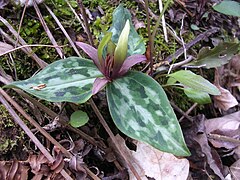Trillium reliquum
| Habit | herbaceous
| |
|---|---|---|
| Lifespan: | ⌛ | perennial |
| Exposure: | ☼ | part-sun |
|---|---|---|
| Water: | ◍ | moist |
| Features: | ✓ | flowers, foliage |
| Flower features: | ❀ | purple |
|
Trillium > |
reliquum > |
Trillium reliquum (also known as Relict trillium, Confederate trillium, and Confederate wakerobin) is a monocotyledon species of the Trillium genus, a perennial, flowering, herbaceous plant of the Liliaceae family and found only in the southeastern region of the United States: southwest, central and east central Alabama, Georgia and South Carolina. It is "redicual", that is there are a few remaining groups of a species that was once more abundant. Significant habitat loss has occurred through clearing of forests for agricultural and pine farm uses.[1] On Apr 4, 1988, it was officially listed as an endangered species.[2] The common name varies by location.[3] It grows in undisturbed hardwood forests that sometimes include mature pines and that are free of understory plants such as bushes and vines. It likes moist, well-drained soils along the banks of streams and small stream floodplains, mixed with other wildflowers and forest debris.[4]
Trillium reliquum has a sessile flower on a curved stem at the center of its three mottled leaves that are blue-green, to green to silver in color. It flowers from March to April.[1] From the end of a stocky underground rhizome, the plant sprouts a single shoot topped by the three mottled leaves and a single sessile flower; the flower is only half the size of the the leaves. The stem is normally not erect, but rather lies along the ground. The flower consists of three petals, alternating with three sepals.[5] The flowers can be greenish to brownish-purple and even pure yellow at times. Its three sepals spread out and usually are a purple color on the inside. The three petals tend to be erect and somewhat twisted, varying from dark purple to yellow in color. The petals are about twice as long as the stamens.[6] The fruit, which is a round, fleshy capsule, appears from May to June.
Cultivation
Propagation
Pests and diseases
Varieties
Gallery
References
- ↑ 1.0 1.1 http://www.georgiawildlife.org/assets/documents/trilre.pdf
- ↑ http://ecos.fws.gov/speciesProfile/profile/speciesProfile.action?spcode=Q2RG
- ↑ http://plants.usda.gov/java/profile?symbol=TRRE6
- ↑ http://www.sas.usace.army.mil/prtillm.htm
- ↑ http://books.google.com/books?id=wFdWlrnz_uoC&pg=PA1540&lpg=PA1540&dq=Relict+trillium&source=bl&ots=ysQurUOKXU&sig=V0U0q2nDstiawfVfLCCl6FupZf4&hl=en&ei=_akAS4ONOMmTnQflmowQ&sa=X&oi=book_result&ct=result&resnum=4&ved=0CBEQ6AEwAzgK#v=onepage&q=Relict%20trillium&f=false
- ↑ http://www.goldendelighthoney.com/tes/TRRE6/trre_text.html
External links
- w:Trillium reliquum. Some of the material on this page may be from Wikipedia, under the Creative Commons license.
- Trillium reliquum QR Code (Size 50, 100, 200, 500)
